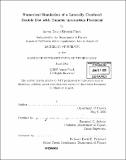Numerical simulation of a laterally confined double dot with tunable interaction potential
Author(s)
Finck, Aaron David Kiyoshi
DownloadFull printable version (2.282Mb)
Other Contributors
Massachusetts Institute of Technology. Dept. of Physics.
Advisor
Raymond C. Ashoori.
Terms of use
Metadata
Show full item recordAbstract
Recent technological advances have allowed for the construction of small (on the order of 100-1000 nm) systems of confined electrons called quantum dots. Often kept within semiconductor heterostructures, these systems are small enough that the electrons within them occupy states with discrete energy levels. Two single quantum dots can be placed next to each other so as to form a double dot, with a host of special properties. Such properties can be probed if one can design the semiconductor heterostructure containing the double dot so that experimenters can tune the confinement potential of the double dot. To assist in the testing of heterostructures before their actual construction, we have created a numerical simulation program that calculates the electrostatic potential and charge density for a quantum double dot housed in a semiconductor heterostructure. Relaxation techniques were used to solve Poisson's equation for the heterostructure. The Thomas-Fermi approximation was used to calculate the electron density as a function of the spatially varying electrostatic potential. (cont.) Certain parameters of the simulation, such as the doping density of the semiconductor material and the electron effective mass, were chosen after trial and error such that the behavior of the simulation matched experimentally observable values, including the electron density within and outside of the quantum double dot region and the depletion voltage. Once the free parameters were chosen, the simulation was used to examine various heterostructure geometries with gates that could tune the confinement potential of the double dot. For example, we analyzed a pincher gate geometry that could split the double dot into two isolated quantum single dots by increasing the potential barrier in the channel connecting the two lobes of the double dot. We discovered that such a tunable dot requires a pincher gate that runs continuously across the bottom of the top gate. We also analyzed how two middle gates., each positioned directly above one of the two lobes of the double dot, can shape the relative sizes of the two connected dots.
Description
Thesis (S.B.)--Massachusetts Institute of Technology, Dept. of Physics, 2005. Includes bibliographical references (leaves 55-56).
Date issued
2005Department
Massachusetts Institute of Technology. Department of PhysicsPublisher
Massachusetts Institute of Technology
Keywords
Physics.